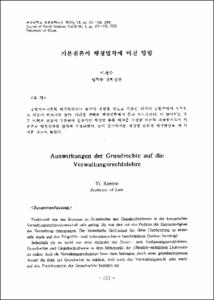有限要素法에 의한 히스테리시스 電動機의 磁束分布 解析
- Alternative Title
- Analysis for Magnetic Field Distribution of Hysteresis Motor using Finite Element Method
- Abstract
- 有限要素法에 의하여 히스테리시스 電動機의 磁束分布를 규명하고 토오크 산출 방법을 제시하였다. 電氣機械의 磁束分布 해석에서 해석적인 해를 얻는 것은 매우 까다롭고, 근자에 많이 사용하고 있는 有限要素法의 경우에도 透磁率이 포함되는 경우 히스테리시스 효과를 다룰 수없어 히스테리시스 電動機의 磁束分布 해석에는 적용할 수가 없다. 본 연구에서는 히스테리시스 電動機의 특성을 규명하기 위하여 磁化의 세기를 포함하는 磁氣 벡터포덴셜의 지배방정식에 有限要素法을 적용하여 回轉子 내의 磁束分布를 구하고 이로부터 回轉子에서 발생하는 回轉力을 고찰하였다. 해석 결과로부터 히스테리시스 電動機의 토오크는 다른 電動機에 비하여 작음을 도출할 수 있었다.
This paper describes an analysis for the magnetic field distributions of hysteresis motors. Based on this, a method for the calculation of the motor torque is proposed. It is very diffcult to obtain a closed form solution for the magnetic field distribution inside the electric motors. FEM(finite element method) is a useful means to magnetic field analysis recently, but it is not able to apply to the magnetic field analysis of hysteresis motor if the governing equation contains the permeability. In order to analyze the field of hysteresis motors. the governing equation containing magnetization strength and MVP(magnetic vector potential) is derived. The solution is obtained by FEM. The flux distributions and torque are calculated from the solution. From the results, it is found that the torque of hysteresis motor is low compared with other motors.
This paper describes an analysis for the magnetic field distributions of hysteresis motors. Based on this, a method for the calculation of the motor torque is proposed. It is very diffcult to obtain a closed form solution for the magnetic field distribution inside the electric motors. FEM(finite element method) is a useful means to magnetic field analysis recently, but it is not able to apply to the magnetic field analysis of hysteresis motor if the governing equation contains the permeability. In order to analyze the field of hysteresis motors. the governing equation containing magnetization strength and MVP(magnetic vector potential) is derived. The solution is obtained by FEM. The flux distributions and torque are calculated from the solution. From the results, it is found that the torque of hysteresis motor is low compared with other motors.
- Issued Date
- 1993
- Type
- Research Laboratory
- Alternative Author(s)
- Koo,Tae-Man
- Publisher
- 공학연구논문집
- Language
- kor
- Rights
- 울산대학교 저작물은 저작권에 의해 보호받습니다.
- Citation Volume
- 24
- Citation Number
- 1
- Citation Start Page
- 47
- Citation End Page
- 57
- Appears in Collections:
- Research Laboratory > Engineering Research
- 파일 목록
-
-
Download
 000002023968.pdf
기타 데이터 / 2.51 MB / Adobe PDF
000002023968.pdf
기타 데이터 / 2.51 MB / Adobe PDF
-
Items in Repository are protected by copyright, with all rights reserved, unless otherwise indicated.